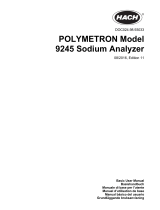Page is loading ...

Operating instructions
LP16-M Thermometer kit 13701
Preparing the LP16-M Infrared Dryer
See overleaf
© Mettler-Toledo GmbH 1999 703131 Printed in Switzerland 9909/2.45
Mettler-Toledo GmbH, Laboratory & Weighing Technologies, CH-8606 Greifensee, Switzerland
Phone +41-1-944 22 11, Fax +41-1-944 30 60, Internet: http://www.mt.com
Subject to technical changes and to the availability
of the accessoires supplied with the instruments.
Check if the protective screen of your LP16-M dryer has a
keyhole-like perforation according to Fig. 1.
If not, an appropriate modification must be made by METTLER
TOLEDO-Service.
Important: Note that termperature measurements cannot be
performed during a drying cycle
Temperature measurement is intended for the two following
applications:
- Measuring the effective temperature of the sample. (The
temperature of the sample is a function of color and compo-
sition of the substance. The instrument has been factory
set, so that a sample of common salt will reach a tempera-
ture of 100°C in 20 minutes.).
- Temperature measurement for calibrating your instrument
with a sample of common salt (sodium chloride).
P703131

screen surface. Retrieve the thermometer and move the clamp
until its lower edge reaches the same position. Then, open the
hood and smooth over the sample surface. Close the hood and
reinsert the thermometer. Now, an impression of a certain depth
is formed within the sample (the thermometer should penetrate
approx. half way into the sample layer - note also Fig. 3). For fine
adjustment the clamp should be moved up or down by a few
graduations, followed by smoothing the sample surface and
rechecking the thermometer penetration. This must be repeated
until the desired value is reached.
Caution: Before opening the hood always remove the thermo-
meter (breaking the thermometer causes the release of mercury).
Preparation for temperature measurement
Thermometer kit includes:
- Thermometer - Plastic clamp - Operating instructions
Before opening the hood of the LP16-M dryer always
remove the thermometer.
An LP16-M applications brochure, containing instruc-
tions for moisture determination, is available on
request.
Temperature measurement procedures
The entire thermometer tip must be in close contact with the
sample. The balance must indicate a value in excess of 100 digits.
(In case of overload or if weighing pan is empty the measuring
cycle cannot be started).
Select the desired temperature, set the timer to 0 minutes (drying
process continues until -Stop- is pressed) and press the start key.
When the temperature ceases to rise at the thermometer, it can
be read off.
Fill in approx. 6 mm of sample substance in sample pan (the
substance must cover the entire bottom surface). Following, slide
the plastic clamp over the thermometer, according to Fig. 2.
Caution: Do not laterally compress clamp, instead press against
base surface and slide into position (slit facing front, so that the
scale remains readable).
Now, place pan containing the sample into LP16-M dryer and
close the hood. Hold the thermometer by the clamp and carefully
insert it into the hole in the screen until contacting the sample.
Note the position on the thermometer graduation matching the
For instrument calibration a sample of common salt (sodium
chloride) is needed. The potentiometer at the right side of the
LP16-M dryer (small cover) permits temperature adjustment.
Clockwise rotation causes temperature increase; adjustable within
± 10°C).
The thermometer must penetrate half way into the
sample layer.
The temperature is a function of substance.
The entire thermometer tip must be in close contact
with the sample.
Summary of important points
Measurements only possible in a sample (not in plain air)
The sample must cover the entire bottom surface of the pan.
Temperature measurement cannot be performed during
a drying cycle.
/



